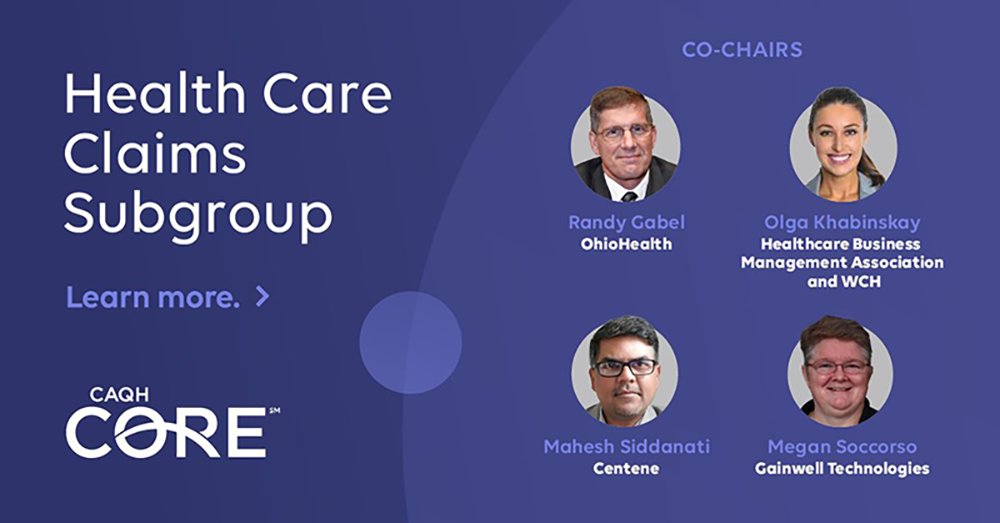Message from Health Care Claims Subgroup Co-Chairs: Rule Development Update

As representatives of healthcare business services companies, provider organizations, health plans, and associations, we spend time optimizing data transmission workflows to improve healthcare administration in our day-to-day jobs. Within the health care claims processing landscape, efficiency remains a key challenge. Per the 2022 CAQH Index, over 9 billion claims transactions are sent electronically between providers and health plans each year— even a small change in automating the standards for claims transmission could result in $2.5 billion of savings annually. The opportunity to influence the industry at scale is why we serve as Co-chairs of the CAQH CORE Health Care Claims Subgroup.
CAQH CORE is steadfast in its commitment to drive industry collaboration and promote streamlined transactions, and in our role as Co-chairs, we are excited to share the progress achieved so far by the Subgroup.
Subgroup Work:
The Health Care Claims Subgroup's goal is to develop a set of data content operating rules that enhance the electronic exchange of claims-related transactions. These operating rules aim to ensure that healthcare providers, health plans, and clearinghouses can communicate, exchange, and process claims more accurately and efficiently.
With nearly 90 active participants, the Subgroup met three times to date and enthusiastically discussed opportunity areas for potential health care claims data content operating rule requirements. We are encouraged by the productivity of the conversations, driven by a shared vision of a standardized, more efficient claims workflow. Below are key areas where we are focused on making an impact:
- Aligning on an approach for Telehealth claim submission
- In a post-Covid world, how should we bill a telehealth claim? A standardized approach to using place of service (POS) and modifier codes in telehealth billing reduces the administrative burden associated with tracking different coding requirements between different entities.
- Standardized usage of the X12 277CA transaction
- This transaction is meant to inform clean claim submission, so why don’t all providers and plans support it? The 277CA reports back to providers the status of a claim as it enters a health plan’s adjudication system, and is often misused. Used correctly, providers can receive clear and unambiguous reporting if a claim is rejected, which allows for speedy correction and resubmission. Standardizing the use of the 277CA could reduce the need for manual intervention and support development of robotic process automation (RPA) for clean claims submission.
- Submitting multiple claims for a single encounter
- If a provider needs to submit more than one claim for a single encounter, how should they do so? Because the X12 v5010 837P limits the number of diagnoses that can be submitted on a single claim to 12, providers may have to submit an additional claim for a single encounter to capture all relevant patient characteristics revealed during the visit. Often, risk adjustment, quality measurement, and indicators of health-related social needs are documented through the inclusion of an ICD-10 diagnosis on a claim. Health plans accept additional claims, but requirements to avoid duplication vary, leading to unstandardized workflows to support this complex process.
- Coordination of Benefits (COB) claim submission
- How can we simplify submitting claims to secondary health plans? Managing COB billing guidelines and electronic vs manual claim submission to the secondary health plan are burdens that, with some standardization, could make COB workflows streamlined, predicable, and expeditious, and reduce COB, timely filing, or other denials.
Subgroup engagement and lively debate in each meeting makes it clear that these topics are shared burdens between providers, plans, and vendors. We anticipate that alignment on a topic as simple as Telehealth POS assignment eliminates confusion in provider billing offices, opens doors for streamlined IT infrastructure for vendors, and increases clean claims for health plans.
Conclusion:
We are all excited to work with CAQH CORE as we seek our shared goal of a uniform, automated, and less administratively burdened healthcare system. We welcome and encourage additional participation from all healthcare organizations. The development of operating rules is essential to achieving burden reduction goals, and the Health Care Claims Subgroup is helping us get there. It’s not too late to get involved with this work; if your organization is interested in getting involved, please reach Peter Benziger, Sr. Manager, CAQH CORE at pbenziger@caqh.org.
